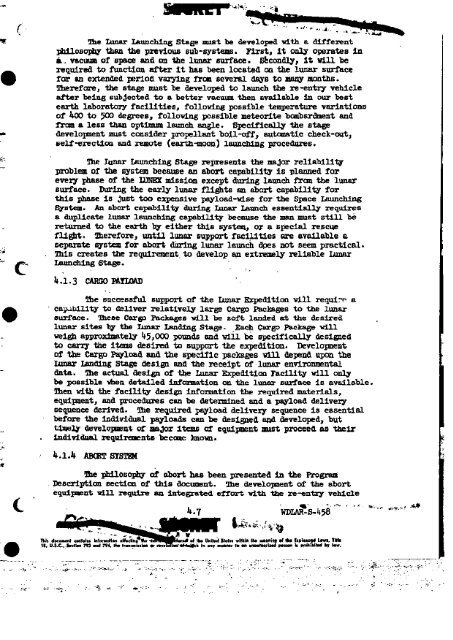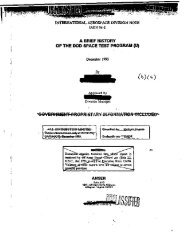LUNAR EXPEDITION PLAN
LUNAR EXPEDITION PLAN
LUNAR EXPEDITION PLAN
You also want an ePaper? Increase the reach of your titles
YUMPU automatically turns print PDFs into web optimized ePapers that Google loves.
(<br />
-«H : -<br />
The lunar launching Stage must be developed with a different<br />
philosophy than the previous sub-systems. First, it only operates in<br />
a„ vacuum of space and on the lunar surface. Secondly, it will be<br />
required to function after it has been located on the lunar surface<br />
for an extended period varying from several days to many months.<br />
Therefore, the stage must be developed to launch the re-entry vehicle<br />
after being subjected to a better vacuum then available in our best<br />
earth laboratory facilities, following possible temperature variations<br />
of 400 to 50Q degrees, following possible meteorite bombardment and<br />
from a less than optimum launch angle. Specifically the stage<br />
development must consider propellent boil-off, automatic check-out,<br />
self-erection and remote (earth-moon) launching procedures.<br />
The Lunar Launching Stage represents the major reliability<br />
problem of the system because an abort capability is planned for<br />
every phase of the LUNEX mission except during launch from the lunar<br />
surface. During the early lunar flights an abort capability for<br />
this phase is Just too expensive payload-vise for the Space Launching<br />
System. An abort capability during Lunar Launch essentially requires<br />
a duplicate lunar launching capability because the man must still be<br />
returned to the earth by either this system, or a special rescue<br />
flight. Therefore, until lunar support facilities ere available a<br />
separate system for abort during lunar launch does not seem practical.<br />
This creates the requirement, to develop an extremely reliable Lunar<br />
Launching Stage.<br />
fc.1.3 CARGO BftTLOAD<br />
The successful support of the Lunar Expedition -will require a<br />
capability to deliver relatively large Cargo packages to the lunar<br />
surface. These Cargo packages vill be soft landed at the desired<br />
lunar sites by the Lunar Landing Stage. Each Cargo Package will<br />
weigh approximately ^5,000 pounds and wiil be specifically designed<br />
to carry the items desired to support the expedition. Development<br />
of the Cargo Payload and the specific packages will depend upon the<br />
Lunar Landing Stage design and the receipt of lunar environmental<br />
data. The actual design of the Lunar Expedition Facility will only<br />
be possible when detailed information on the lunar surface is available.<br />
Then with the facility design information the required materials,<br />
equipment, and procedures can be determined and a payload delivery<br />
sequence derived. The required payload delivery sequence is essential<br />
before the individual payloads can be designed and developed, but<br />
timely development of major items of equipment must proceed as their<br />
Individual requirements become known.<br />
It.1.4 ABCfiT SYSTEM<br />
The philosophy of abort has been presented In the Program<br />
Description section of this document. The development of the abort<br />
equipment will require an integrated effort with the re-entry vehicle<br />
WDLAR-S-lf58<br />
. ^ . : :<br />
1M* ri»»«iil wUslu MbnmHan .ffadingT*. *3HMB(lwi.* •« Hn U.IM Holn «»KlH H* aiMn'rBt *f Hw Eiptwnt* L*wi, IHta<br />
II, U.S.C., fecttan 793 ""J 7M.




